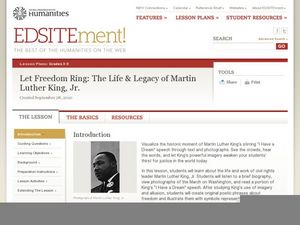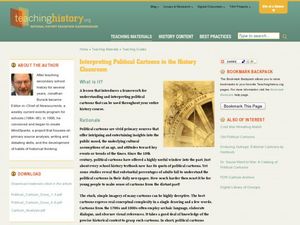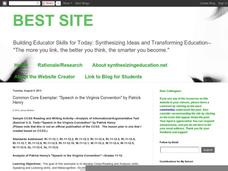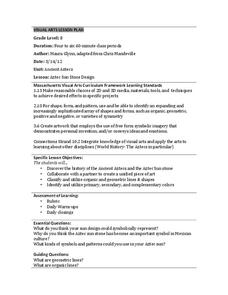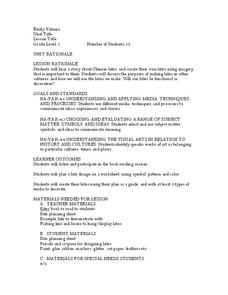Curated OER
A More Perfect Union: The Story of Our Constitution
Sit back, relax, and transport to 1787! This lesson on the Constitution begins with guided imagery of the Constitutional Convention. The class reads A More Perfect Union: The Story of Our Constitution in an...
Curated OER
A Guided Journey Into the Past
Fourth graders use guided imagery to discover and judge an alternative way to enjoy artifacts without removing them from archaeological sites.
Association of American Geographers
Project GeoSTART
Investigate the fascinating, yet terrifying phenomenon of hurricanes from the safety of your classroom using this earth science unit. Focusing on developing young scientists' spacial thinking skills, these lessons engage...
Smithsonian Institution
A Ticket to Philly—In 1769: Thinking about Cities, Then and Now
While cities had only a small fraction of the population in colonial America, they played a significant role in pre-revolutionary years, and this was certainly true for the largest city in the North American colonies: Philadelphia. Your...
Curated OER
Let Freedom Ring: The Life & Legacy of Martin Luther King, Jr.
Young scholars use text and photos to visualize the delivery of Dr. Martin Luther King, Jr.'s historic "I Have A Dream" speech. They analyze Dr. King's speech for examples of imagery and allusion and create original poetry and...
Curated OER
Men and Women
Students explore gender roles and expectations of women in society. For this gender roles lesson, students read the play Much Ado About Nothing and give examples of imagery in the play that express men's expectation of women.
Curated OER
Thematic Poetry Videos
Students pen poetry regarding global issues. In this information literacy lesson, students research global issues and use their findings to compose poems regarding the topics. Students create videos that include images and the the text...
National Endowment for the Humanities
Jacob Lawrence's Migration Series: Removing the Mask
Describe, analyze, compare and contrast poets from the Harlem Renaissance. Critical thinkers analyze the imagery, characterization, tone, symbolism, and historical context of Jacob Lawrence, Helene Johnson, and Paul Laurence Dunbar. A...
Curated OER
Cartoons: How Have Society's Views of Women Changed Over Time?
Students explore women's rights by viewing cartoon images. In this women's history lesson, students view several images depicting women in a certain way while discussing the meaning of the imagery among their classmates. Students write a...
Facing History and Ourselves
#IfTheyGunnedMeDown
As part of their continued investigation of the reporting of the shooting of Michael Brown class members analyze photos of Michael Brown and the social media response to these images. The class then develops a guide they...
Curated OER
Imagining China through Words
When Europeans first came back with tales of China, they provided vivid written accounts and minimal visual imput. This resulted in art rendered mostly from descriptive language. Learners explore this phenomena by listening to...
Curated OER
Interpreting Political Cartoons in the History Classroom
Learners analyze political cartoons. In this historical perspectives lesson plan, students use the provided cartoon analysis worksheet to examine the political cartoons that their instructor shares with them.
Curated OER
Speech in the Virginia Convention
“. . .different men often see the same subject in different lights. . .” but the great orator Patrick Henry used all the skills at his command to craft a speech to convince listeners to see things as he did--that liberty was worth dying...
Curated OER
Stitching Truth Lesson Two: The Arpilleristas in Pinochet's Chile
High schoolers analyze arpilleras. In this Chilean history instructional activity, students examine social justice issues as they read and interpret arpilleras. High schoolers study the tapestries to learn about Augusto Pinochet and his...
Facing History and Ourselves
The Power of Images
One picture but a thousand stories. As a part of a case study of how the death of Michael Brown was reported by professional news sources and on social media class members examine the reactions of various groups to a photograph taken by...
Curated OER
Ancient Aztecs
Is it a calendar? A religious symbol? A political statement? One thing for certain is that Aztec sun stone designs remain an important symbol in Mexican cultural art. Young artists craft their own Aztec Sun design incorporating ideas...
Curated OER
The Civil Rights Movement
Students analyze the tensions that existed in American society during the Civil Rights Era as well as the problems that children experienced. They evaluate editorial cartoons dealing with the American Civil Rights movement to view the...
Curated OER
Sea to Sky
Students investigate the Earth's major landforms and how they occur, and how engineers apply this knowledge for the design of transportation systems, mining, and measuring natural hazards. They listen to a teacher-led lecture, match...
Curated OER
Celebrating the Day of the Dead
Students explore the artwork of the Indo-Hispanic holiday of Day of the Dead. They view images, define key vocabulary terms, and plan and create a two- and three-dimensional sculptural figure.
Curated OER
Chinese Kites
First graders investigate the concept of kite making in the culture of China. They design and create their own kites. The purposes of making kites is discussed and the question of a kite's functionality is covered.
Curated OER
The Displacement of the Native Americans
Seventh graders comprehend the interaction and conflict between Native Americans and white settlers in the years following the Civil War. They examine how those conflicts impacted the Native American way of life on the Great Plains.
Curated OER
Hiroshima, From All Sides
Students comprehend how the Atomic Bomb affected humanity and ended WWII. They comprehend how the Atomic Bomb affected: scientists, Japanese citizens, and US leaders. Students receive a copy of Hiroshima, Readers Theater Rubiv. They...
Curated OER
Images of Gary: An Ideal Place to Live?
Students examine photographs depicting historical scenes from the US Steel Photograph Collection. They develop criteria to analyze or judge an image's representation. They assess photographs according to the criteria.




